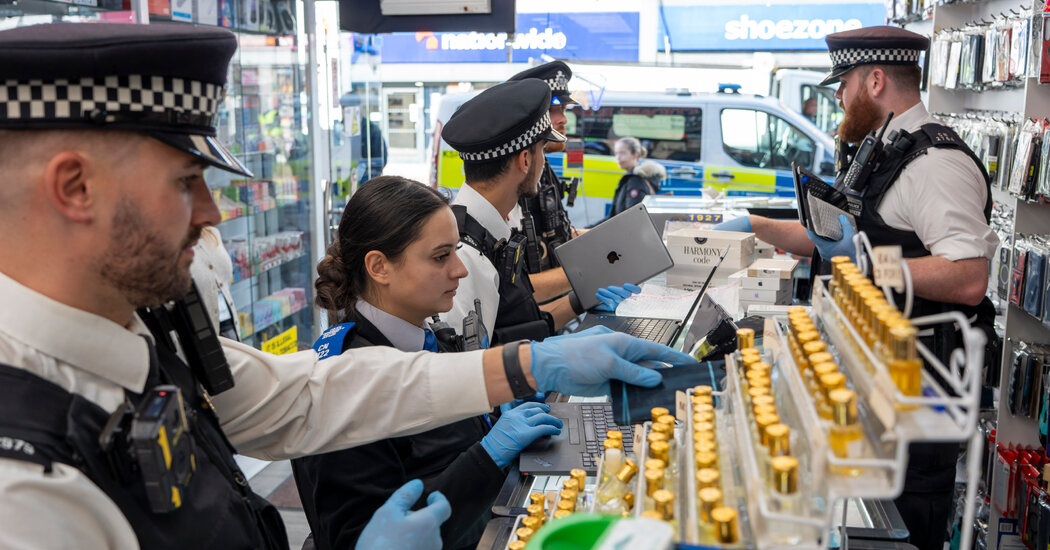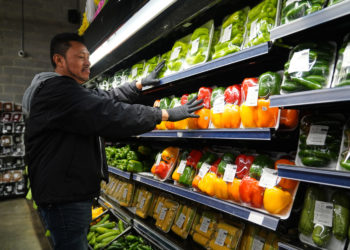Times Insider explains who we are and what we do and delivers behind-the-scenes insights into how our journalism comes together.
The first time I was targeted by a phone snatcher was in London in 2012. It was during the Summer Olympics, and I was standing on a train station platform checking the scores for a tennis match.
I heard somebody running but thought little of it until moments later, when my work-issued iPhone 4 was ripped out of my hands. I ran after the culprit, who was much faster and escaped. By the time the police caught him days later, the phone was long gone; it was sold, they believed, at one of the many secondhand phone shops in east London.
The next phone-related incident happened shortly before the Covid pandemic, when I was walking out of a Tube station. A passing cyclist, with their face covered by a mask, grabbed my phone but failed to wrench it from my hand.
I did not know that phone snatchings would become ever more common in London over the coming years — or that an illicit export market to China was allowing the thefts to thrive. That was one of my and Amelia Nierenberg’s findings from a recent New York Times investigation into London’s phone-theft problem.
Last year, there were roughly 80,000 phone thefts in the British capital, where I have lived for 14 years. Amelia, too, was nearly a victim.
Last October, she was at a train station carrying a sheet cake when she felt someone lifting her phone out of her coat pocket. She reflexively grabbed the thief around the neck until he let go. Both the phone and the cake survived the encounter, but Amelia was determined to dig into this crime epidemic.
So when Mark Rowley, the commissioner of the Metropolitan Police, said last month that his officers were planning to raid three secondhand phone shops in the city, it presented the perfect opportunity for us to find out how phone theft had become prevalent, and why the police response appeared dismal.
The police invited Times journalists to attend a raid at one of several shops suspected of buying stolen cellphones. Some of the stores, I was told, would sell the devices to customers, or ready them for export.
Last month, the photographer Andrew Testa and I met at Holloway Police Station, in north London, where police officers were being briefed on the operation. We were put in an unmarked police car and sped out of the station in a convoy of blaring sirens and flashing blue lights that sliced through traffic on the busy street where the businesses were located.
We ran in behind the police as they entered an unassuming secondhand phone shop with a blue Metropolitan Police-branded sticker on the door declaring itself to be a “safe seller” that would “check the legitimacy of secondhand items.”
We watched as the police checked the devices’ identification numbers against databases of phones that had been reported stolen, and examined rows of phones on display below a sign warning: “NO REFUNDS.” The shop owner and an assistant were questioned by the police, and directed them to two safes that were filled with mobile phones, £370 in cash, letters and passports.
After I interviewed the officer leading the raid, we left the police to their work. I was later informed that none of the phones examined were found to be stolen, and no action was taken against the two men questioned. At two other shops being searched at the same time, officers found five stolen phones and about £40,000 in cash.
Later, at a news conference, investigators said they had discovered thousands of stolen phones before they could be sent to China. The devices were found because of a tip from a victim who had tracked her stolen iPhone to a warehouse near Heathrow Airport.
Our investigation, which was published this month, explained how a shrinking number of police patrols and the spread of speedy e-bikes were among the factors that have contributed to the spike of phone theft in London, and drew an incredible response from readers.
As journalists, we are often attracted to the new, the bizarre and the extreme, but the scale of interest from readers was a timely reminder that it is the most common crimes that directly affect most people’s lives.
We are aware that in many ways, the article poses more questions than it answers. Why would iPhones stolen in Europe be in such demand in China? How would the newest models garner prices, as the police claimed, of up to $5,000 when they can be legally purchased there for less? Those are questions that we will continue to try to answer.
The post Police Raided a London Shop. We Tagged Along. appeared first on New York Times.




